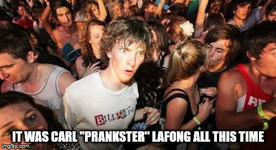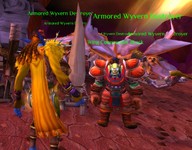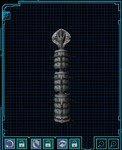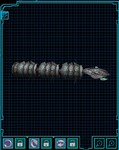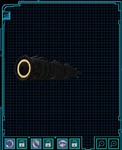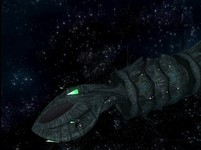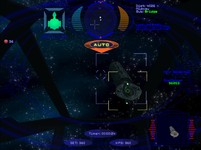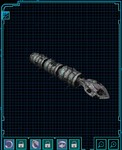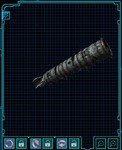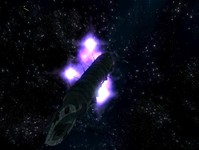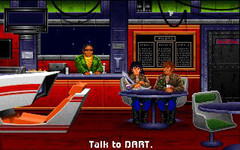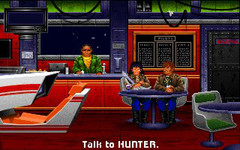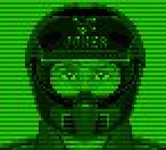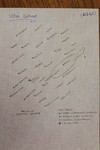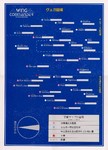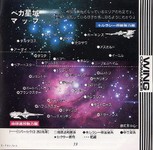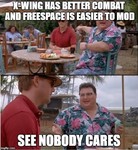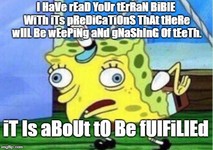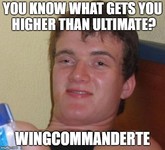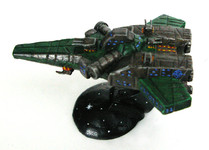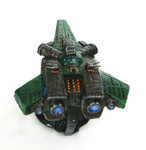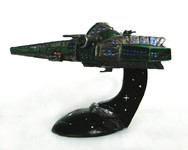[feedquote='Wing Commander News','https://www.wcnews.com/index.shtml#11711']It's a
possibilityPosts by Bot
-
-
[feedquote='Wing Commander News','https://www.wcnews.com/index.shtml#11703']
Dowlphinspotted a couple of nifty easter eggs in a recent World of Warcraft quest. Wing Commander Black and a blue-haired Kilrath make appearances as a couple of Orcs in a story mission. These aren't random gaming references either - WoW executive producer
J Allen Brackis a major Wing Commander vet. He got his start in the industry as a QA tester on Wing Commander 3 and went on to work on P2, WC4, Kilrathi Saga, Prophecy and Secret Ops. There are likely numerous such gems hidden in the game. Another player spotted
Wing Commander Mulvericka while back too.
-
Contents [Hide]
- 1 VEHICLE FEATURES
- 2 VEHICLE PIPELINE
- 3 GAMEPLAY FEATURES
- 4 NARRATIVE
- 5 CHARACTERS
- 6 DESIGN
- 7 ART
- 8 BACKEND SERVICES
- 9 ANIMATION
- 10 OPERATIONS
- 11 GRAPHICS
- 12 UI
- 13 ANIMATION
- 14 GAMEPLAY STORY
- 15 ENGINEERING/PROGRAMMING
- 16 SHIPS
- 17 AUDIO
- 18 ENVIRONMENT ART
- 19 VFX
- 20 WEAPONS
- 21 ENGINE TOOLS
- 22 VFX
- 23 LIGHTING
- 24 ENVIRONMENT ART
- 25 QA
- 26 TECH ART
- 27 CINEMATICS
- 28 ENGINE
- 29 BUILD ENGINEERING
- 30 AI
- 31 SYSTEM DESIGN
- 32 LEVEL DESIGN
- 33 SPECTRUM
- 34 RSI PLATFORM
- 35 KNOWLEDGE BASE
[feedquote='Star Citizen','https://robertsspaceindustries.com/comm-link/transmission/16551-Monthly-Studio-Report-April-2018']
Monthly Studio Report: April 2018
Welcome to Cloud Imperium Games’ Monthly Studio Report for April, bringing you insight into what all of our studios have been working on. This month, the team delivered multiple updates to Alpha 3.1, made advancements on a variety of new systems and features, like scanning and mining, and continued development on Squadron 42. With that said, let’s get to it.
Los Angeles

LOS ANGELES
VEHICLE FEATURES
The team focused on two major priorities in April: one was the scanning feature, which is making good progress. The focus has been on the code-side that will be used throughout Star Citizen, including for Mining and in Squadron 42. The other priority was Object Container Streaming development, as it relates to making vehicles thread safe. This is one step toward a larger goal being worked on across the company — to provide a significant performance increase in the game. In addition to these tasks, the team provided support in various areas, such as fixing crash bugs on the 3.1 stream, assisting in development on the Anvil Hurricane, and tackling bugs in areas of the game that were hindering development.
VEHICLE PIPELINE
Tech Design completed their initial set-up of the Anvil F8 Lightning. They’ve also been setting up the Anvil Hurricane while the Art Team wraps up their work ahead of the Alpha 3.2 release. Tech Art will begin the damage pass on the Hurricane soon. The teams are looking forward to adding the Hurricane to the list of flyable ships. Tech Design and Art were also busy collaborating on the Consolidated Outland Mustang revision.
Currently, Tech Art is tackling damage passes for the Aegis Avenger revision and Origin 600i, as well as implementing landing gear compression on various ships. Tech Art also supported various teams and features such as Mining. The MISC Prospector is getting a working boom arm that carries the mining and tractor beam tools. The boom arm will work like a turret and aim where the pilot looks so it can mine asteroids. Tech Art created the boom arm ‘rig’ for the Animation Team, and will help put the asset and animation states into the game.


GAMEPLAY FEATURES
The team developed in-game support for groups that will be accessible on the player’s mobiGlas and Visor. They worked closely with the Spectrum and Backend Services teams to ensure that the feature is as seamless and integrated as possible. The teams met daily to make sure everyone was on the same page, and swift progress lead to the team outlining the Spectrum API to support Groups and Lobbies (which enable Chat functionality). Turbulent will soon implement a stub service according to the spec’d-out API, at which point the team can implement the client side. This will allow both teams to work in parallel, which speeds up development. Once the Spectrum-enabled service is ready, the client team will replace the stub with the real spectrum-enabled service. This will allow the team to test and add more features to the groups system going forward.
NARRATIVE
The Narrative Team delivered a wide variety of content in April. Loremaker’s Guide to the Galaxy toured the Nul system, the new serialized fiction series One Good Deed came to a dramatic end, and another issue of Jump Point was published. The team also delivered content for the Origin 100 brochure and sale page, alongside a host of other marketing materials.
Meanwhile, the team worked with art and design to develop a series of templates to not only help flesh out locations and biomes across the Star Citizen universe, but provide a single, consolidated page for anyone in the company to seek out information. Additionally, they worked with design to expand the current list of commodities and resources, kick-off text needs for new 3.2 mission content, and deliver a number of weapon descriptions for new items being added to the game in upcoming releases.
For Squadron 42, there were several playthrough reviews at that start of the month that were helpful in highlighting areas that could use an additional environmental storytelling pass. Several documents were then created to assist the Environment Art and Props teams that proposed specific props and set decorations that could help sell the flavor of that particular moment. The team also completed a pass at ensuring all other remaining Squadron 42 narrative tasks have been properly identified and written up so that production can better track the work left to be done.
CHARACTERS

Character Team highlights included revising the Persistent Universe undersuit and all the different legacy armor sets for Marines and Outlaws. The latter progressed well with the release goal being Alpha 3.2.0. The team also completed rounds of R&D on how to implement hair in a more in-depth way than the current system. The team also made solid progress on upcoming Mission Givers and clothing for the Olisar Collection.
For Squadron 42, the team worked on many of the principal characters and also moved forward on how they’ll deliver alien archetypes, while collaborating with the Weapons and AI teams to ensure they’re working within established in-game metrics.
Finally, the Character Team worked with the Graphics Team to implement the updated glass shader tech that debuted in the Around the Verse’s Squadron 42 update onto the existing helmets. They also modeled various fauna that will bring more life to the ‘verse in the future.


Austin

AUSTIN
DESIGN

Designers put in fixes for the 3.1 release, planned and chipped away at 3.2 goals, and started moving forward with the new pricing model, and incorporating an internal recipe component for each item in the game. This involves extending the commodity and resource list to make it more representative of the final product. Recipes are broken out into three major components: resources, materials and parts. Basic resources can be mined/scavenged around the universe. Those resources can be delivered to refineries and transformed into materials. Finally, manufacturers will combine resources and materials to create parts. The finished purchasable items are comprised of a combination of logical parts and materials. This is responsible for a portion of the item’s price, which will give players the ability to exert influence on the price through avenues such as mining, trading, scavenging resources, etc.
The team has also been focused on two major things. First, allowing players to quantum travel as a group with Quantum Linking. They’ve decided to incorporate this into the party system to make it more intuitive for the players. They’re also adding a calibration state, so destinations will need to be calibrated prior to quantum travel (QT) being initiated. Whether or not a group can quantum will be entirely dependent on party members being near each other, and aligning towards the QT Destination being calibrated. Once the target is calibrated, the master calibrator can enable the quantum for all aligned members.
The Design Team also added “Orbital Splines.” These will allow the player to select a destination on the surface of the planet, assuming they’re inside that planet’s sphere of influence, and travel to any known location in a single quantum jump. This system generates a spline for the player to travel on. For the first iteration, IFCS will likely align the ship when the player initiates the QT. The ship will travel along the created spline above the atmosphere with the destination in view at the end of the QT, and the trajectory will aim the ship down into the atmosphere once it’s arrived. The team believes this feature will enhance the planetary QT experience. QT will NOT be functional in atmosphere, but once a ship has exited the atmosphere, it can jump to another surface location in a single QT.
Finally, Design implemented animations for Levski’s next two mission givers: Recco Battaglia and Wallace Klim. R&D went into creating and implementing a script that will batch import the animation list based on a csv file. This will save a ton of time in the future. The team is focused on getting these whiteboxes signed off and into the game. While they are not on the current roadmap, if ready, they may make an appearance in 3.2.
ART

The ATX Ship Art Team concentrated on the high-poly modeling phase of the Constellation Phoenix. They worked to get some interior areas to a ‘final’ stage, which helps them move onto the next area. In a couple of weeks, they will start the ship setup process, model out the damage/LODs, and get the interaction areas working correctly alongside the Tech Design department.
They also continued the detail pass on the F8 Lightning by applying the POMs, decals and final geo tweaks. They are currently concentrating on the cockpit, which requires a lot of attention to detail and making sure the interaction points / screens are lined up correctly. After this detail phase, they will work with Tech Design on the ship setup (damage, LODs).


BACKEND SERVICES
Server Engineering worked closely with Turbulent in planning the bridge between Spectrum and Diffusion services. In addition, they’ve created further services under the new architecture. The first is the login service, which coordinates and streamlines the initial login process for the client with the backend. The new login service better manages authentication, notifies required back end components, processes new entitlements (items, rentals), and handles error reporting. They also started planning for new services such as Reputation, Wallet, Badge and Insurance. Finally, the team integrated new tech into the main game code and continued to phase out older technology.
ANIMATION
The PU Animation Team worked on Mission Givers Battaglia and Brunt, and a gruff female shopkeeper. Animations for the Mission Givers are being polished, while those for the shopkeeper are in the implementation phase. Design also provided support by getting these characters hooked up in game. Additionally, ATX aided other animation teams with mocap cleaning and solving, and kicked off R&D on the bartender and bartending functionality.
The Ship Animation Team also took time to improve the current animation pipeline and processes, streamlining the overall process in order to free up animators to work on new feature updates for cockpits. This includes updates to all cockpit types, trigger presses, button presses, and the general cockpit experience. In addition, the team continued work related to the 3.2 release. The planned ships for the release include the Origin 600i, Anvil Hurricane, Aegis Eclipse, and Vanduul Blade. 3.2 also includes art and animation updates to the Aegis Avenger series, and new features that affect ship animations, like the mining arm on the MISC Prospector and manned turrets in vehicles. Finally, the team fixed various bugs and issues that cropped up.
OPERATIONS
The DevOps Publishing Team supported daily publishes for the 3.1.x development cycle. They spent the remaining time analyzing gameplay data and performance analytics, providing daily reports to assist the development effort. The team rolled out additional enhancements to internal performance analytics, allowing them to measure client and server performance indicators at much more detailed levels than before. These analytics can get down to minute levels of detail to help the dev team monitor and tune things like memory consumption by process, processor load by activity, and bandwidth utilization per task.
The DevOps BuildOps Team shifted from performance and stability to feature enhancements on the overall build system. This work included new services that enable more finely tuned patches, allowing for more rapid last minute changes. They also rolled out the initial stages of a new internal build process, which breaks out separate build branches to the feature team level. The goal is to reduce internal iteration time for individual feature teams, so they don’t have to wait on the larger internal builds to test their work. Dev teams have provided positive feedback and look forward to the knock-on effect this will have on individual feature development.
April was a busy month of balancing priorities for ATX QA. They helped development with fast iterations to the PTU for final fixes of the 3.1.0 cycle. These took the form of patches 3.1.1, 3.1.2, and 3.1.3. Each requiring support from QA to test the build, environment and launcher, monitor results, and provide data to the developers.
QA also paid attention to Game-Dev and 3.2 preparations. They bugged up issues that crept in while focus was on the publish cycle, and cleared out the backlogged fixes that needed to be verified. These included mission dialog and reward updates, updates to Field of View transitions, connection recovery, IFCS control systems, and various code changes to entity management.
Other projects included an extensive pass over turret functionality and starter ships to help live design identify and prioritize problem areas. The tech team tested updates to the Autodesk tools in advance of them rolling out to developers, as well as new launcher fixes from Turbulent. The Player Relations Team coordinated with several other teams to get 3.1.3 to Live and 3.1.4 to PTU. The 3.1.4 update includes some much anticipated IFCS changes and crash fixes. With 3.1.3 out and 3.1.4 on the way, the team would like to remind and encourage everyone to use the Issue Council to help the team triage and rate bugs and functionality. That data gets used to prioritize future updates, plus Issue Council participation will make players eligible to get into earlier PTU waves.
Wilmslow & Derby

WILMSLOW & DERBY
GRAPHICS
The Graphics Team spent the month on R&D in four different areas. The first is a new multi-layered shader system, which provides a generalized workflow for creating and sharing material layers that can be dynamically combined using the HardSurface and Organic shader currently under development. This system will allow Art Teams to share a similar workflow when it comes to dynamic wear and dirt build-up, unifying the appearance of these important visual features across the game.
The second R&D topic was multi-resolution gas clouds, which allows the placement of smaller, more detailed gas clouds inside larger clouds to provide the equivalent of a bespoke location on a planet. This was a particularly complex task because the volumetric nature of gas clouds means that the team had to solve issues with lighting, shadows, sorting, and density seams. This tech is crucial for Squadron 42, but will also be used for building missions in the PU.
The rest of the team worked on generalized GPU particle spline support to improve effects such as beam weapons and lightning, improved glass shading for more realistic and dynamic ship canopies and visors, and provided general improvements for all glass and transparent materials.
UI
The team spent the start of the month planning for Q2, with Mining and Ship Item Kiosks being two features in need of support. The Mining HUD was designed and iterated on throughout the month with implementation work starting soon. Prototyping progressed in the wireframe stage for Ship Item Kiosks, which helps identify issues with the UX before final artwork is created. Alongside these tasks, the team continued to support the Rest Stops being created by Art. Generic utilitarian environment branding sheets are also being designed to allow the Art Team to have variation in the look and lighting of the environments.
Finally, the team made steps to improve the UI Tech. They identified three systems (‘Bindings’, ‘Building Blocks’ and ‘Resource Manager’) that they will scope out and implement over the coming months to make UI creation and prototyping easier for Engineers and Designers.
ANIMATION
The Animation Team worked on Vanduul block-outs to inform the combat design being developed. They also focused on combat AI actions (grenade throws, diving away from grenades, etc.) and tested different combat styles for varied enemy archetypes (untrained vs trained).
The team also spent time on player locomotion (moving stop assets from animation-driven to entity-driven, to give a better parity between local client and server), weapon malfunctions, and tweaks and re-exports to various FPS weapons. They also continued to iron out popping and glitching with the existing usable animation sets. Finally, R&D animation assets were created to test the player knock-down design for combat.
The Facial Animation Team collaborated with the Gameplay Story Team on scenes for Squadron 42. PU facial animation polish is ongoing, and plans are in place to further flesh out the existing PU with face animation, like emotes, etc. They also successfully captured more data at a one-day shoot in Nottingham, UK that will go into production soon.
GAMEPLAY STORY
The team focused on preparing “pre-vis” assets for high priority scenes to assist Design with white-boxing. This meant assembling scenes in Maya, building track view scenes in-game, and adding animations to Mannequin. It is useful to see these scenes appear in context within the level flow, and the team is using this as a springboard to improve the appearance and implementation of these scenes.
ENGINEERING/PROGRAMMING
The Actor Gameplay Teams worked on getting a consistent structure in place for picking up and interacting with items, including a new inspect mode for anything the player carries. Now, players picking up an item can select whether to stow or inspect it. While carrying a weapon in the right hand, the player can also pick up and stow smaller items, such as ammo or medpens. This action can be done in various states, be it standing, crouching, sitting or EVA.
On the weapon front, they’ve been exploring better solutions for the firing recoil, including bullet spread. The investigation begins with what works and feels right for each weapon between animated recoil, procedural recoil, the effect of recoil on the camera, and how it all ties into the bullet spread. By tweaking these elements, the team will be able to tune each weapon to make it feel satisfying and distinct.
Another team has been implementing the new “lean” mechanic, which will primarily be used behind cover. Cover is no longer marked up by Designers as a special “cover” state. Now, it’s much more systemic with the player deciding what to crouch or hide behind, and how to use the environment to their advantage. Being able to lean out and fire is now part of that. They also worked with the Animation Team to improve the look and feel of the start, steps, stops and turns for the player. This was to make the control more responsive, as required from the first-person view, while also looking good in third person or when seen in multiplayer.
They also set up a new vehicle team in the UK to support the LA team. They’re tackling the functionality to overclock ship items and all the advantages and risks that entails. For example, overclocking engines might produce more thrust but they’ll overheat and wear faster. This is part of a holistic system dealing with an item’s quality level, wear, damage, and so on. These factors will ultimately decide how well the item functions, if it misfires or stops working completely.
SHIPS

Work is underway on the next generation of space stations. This begins with Rest Stops that are created semi-procedurally, allowing the team to easily populate the PU with many variations. To accomplish this feat, they have focused on developing the tools and workflow needed to achieve it.
With 3.2 on the horizon, the Ship Art Team pushed hard on the Aegis Eclipse, Aegis Avenger, Origin 600i and Vanduul Blade. Most of the art for these ships is done with the focus now on polish, final lighting and getting the technical things ready, such as landing gear, damage set-up and LODs.
The Concept Team completed tasks for the Origin 100 series starter ships, and continued work on four other ships that range in size from small to large.


AUDIO
The Audio Department strove to convert all the ship audio to the IFCS 2.0 system, tweaking and modifying values to achieve the previous audio benchmarks. Once fully converted, the team will review the ship content to further improve the audio experience.
Another big focus has been designing and implementing the first iteration of audio content for mining. The aim is to achieve a tactile audio experience that both entertains and informs the player. The team also further developed the Foley system, implementing material types to cover all new variants of clothing and armor in the game.
Additionally, the team completed a first pass on both the Gemini F55 and Kastak Arms Scalpel weapons. Finally, the Audio Department collaborated with composer Geoff Zanelli to establish the remaining musical themes and motifs to be featured throughout Squadron 42.
ENVIRONMENT ART
The team concentrated on the last few pieces of the Rest Stop exteriors; mainly the first-person level areas around the smaller landing pad entrances, which require higher detail passes than the rest of the large-scale exterior. On the interiors, they finalized the approved set of rooms and worked with Design to make sure their needs were met. More work went into procedural prop placement and developing the intended workflow and tools. That means they can further vary the content of the Rest Stop interiors dynamically.
On the hangar side, the team is finalizing the greybox set, in particular the large functional wall pieces such as the fuel and repair service modules. They began early material and surfacing breakout exploration. The team is also finalizing the animations for the front and top loading hangar doors, which due to their size have been a challenge to make feel both weighty and ponderous, yet open fast enough so players don’t have to wait too long.


VFX

The VFX Team, which includes dedicated Graphics and Game Code members as well as Artists, supported several feature sprints, including IFCS 2.0, mining and scanning. These feature requirements are pushing the GPU particle system along nicely. This includes the emit-from-spline required for the mining laser beams, but it can also be used to create more efficient lightning or experimental effects, such as space anomalies.
Besides feature support, the team worked on the Anvil Hurricane, the Aegis Avenger rework, and the Kastak Arms Scalpel ballistic sniper rifle. They also investigated general improvements to ballistic weapon effects, such as better muzzles and tracers.
VFX Artists incorporated the curl noise improvements made by the Graphics Team last month into Vanduul and Xi’an-specific effects, giving them a unique visual style that will be easily recognizable at a glance. On the VFX tools front, the team created a plugin that allows them to easily export vector fields from FumeFX to engine, and a new set of plugins to allow for easier integration of Houdini into the Artists’ general pipeline.
Frankfurt

FRANKFURT
WEAPONS
The Weapons Team finished the first art pass for both the Gemini F55 and Klaus & Werner Demeco light machine guns. The team also did research and concept work for personal gadgets and continued various toolset improvements.


ENGINE TOOLS
The Engine Tools Team primarily focused on stability and usability improvements for the game Editor. The main focus was on replacing and improving existing Editor tools that don’t fully cover the team’s needs, or improving iteration times for the Designers, along with preparing future Subsumption integrations and easier Editor plugin creation. The recent work also includes better Data Core integration, improved Object Container workflows, improved Cinematic Tools, improved Editor start-up times, improved Procedural Tools integration, and general Editor stability and code clean-up of legacy code.
VFX
The DE VFX team refined the look of the overall Xi’an tech style. This included rebuilding some of the older existing effects to take advantage of newer technology, such as the Scout death mask explosion and the quantum drive. They’ve also worked on effects for the upcoming resource mining mechanic.
LIGHTING
The primary focus for the Lighting Team centered on the first pass of lighting for the modular Rest Stop system. This involved creating a lighting language and full ruleset that could be applied to each modular piece, so that when a new layout is created the lighting can seamlessly blend between rooms, shops and corridors, while at the same time maintaining a consistent visual style across an entire station.


ENVIRONMENT ART

Hurston and Lorville are in full production with the Environment Art Team. They are about to wrap up a first pass on two Hurston ecosystems, the Trash Mesa and the Acidic biomes.
These new ecosystems will make full use of all the new features and refinements that the team recently worked on with the Engineers. Expect to see improved material transitions, and better integration of things like rock and terrain assets on the surface, giving everything a more natural and integrated look and feel. Lorville also moved into full production, with the city layout and direction approved by all departments. The art focus shifted towards breathing life into the city, its architecture, and the various areas the players will be able to visit.
QA
Prior to the 3.1 release, the QA Team worked with numerous disciplines. Following the release, they focused on supporting the DE Engineering Team. They routinely tested binaries to verify things were functioning as needed before being included into the live branch. They were also tasked with investigating crashes found in the Live release using PageHeap. They often aided the internal development team with various requests throughout the day. From tests to verify if small issues people encountered were due to their local files, or an actual issue within the current build, to the more complex tests that require testing on custom binaries and comparing differences between builds. They also devoted time to Subsumption, performing weekly smoke tests on new versions to ensure its functioning as intended for the Development Team.
TECH ART
The DE Tech Art Team continued rigging work on numerous weapons: the Gemini F55 light machine gun, Kastak Arms Scalpel sniper rifle, and Klaus & Werner Demeco light machine gun.
They completed R&D on leaning with weapons while Aiming Down Sight (ADS). Early implementation on the leaning was done from a proc clip, which is not scalable to the various weapon types and scopes in the game. The new requirements came from the Tech Design Team, and Tech Art provided a flexible solution where Tech Design can easily modify the results. For the v2 character customization system, they did a lot of R&D revolving around artefact-free adaptation of attachment assets (hair, beards, glasses, armor and clothing) to arbitrary face and body shapes at runtime. The goal is to author any attachment only once for a prototypical face or body, and then automatically and smoothly adapt its shape to any player-customized face or unique NPC created by the Art Department. The same system will be used both internally during asset creation and externally by players during character customization and loadout editing. Since characters, including all attachments and their respective LODs, may consist of more than 100k vertices, special emphasis was placed on finding suitable algorithms that can perform this complex task in real-time. Another focus in the development was making sure that the authoring of assets for use with this system is as simple and artist-friendly as possible, so the Art Department can create them efficiently. They also worked on improving multiple tools for the animation and art pipeline, including Playblast Tool, Custom Normals and a Houdini Exporter.
CINEMATICS
The Cinematics Team finished a sprint to get all high-critical and medium priority narrative scenes represented in the Squadron 42 build. Many scenes were already in-progress, but they wanted to give the level design team a full previsualization export of every important performance capture scene that might be relevant for level flow/pacing and specific environmental art needs. The previsualization effort also added Trackview sequences per scene and scene status commentary. During the process, they also cleaned-up character layers and character loadout naming conventions, which was necessary for easy readability of scene setups and performance within the editor. Once completed, they returned to an earlier chapter to dial in the environmental art for a key SPOILER location. Surfacing and materials needed updating to raise them to current standards, and they’re modifying the color scheme to align it with other ships / locations. Progress was also made on one of the most complex, in terms of logistics and numbers of actors, scenes in the middle of the Squadron 42.
ENGINE
The Engine Team directed their attention on various aspects of the engine. The Entity Component Scheduler was refactored to ensure a clearer API (ongoing but nearly finished). The component system has grown over time thanks to work done by different developers that added features. The team first introduced components, then threading, and finally update policies, which reduce the number of components to update. All these updates combined resulted in complex code. The refactor was tackled step by step by making the design more orthogonal, allowing a more flexible way to control components, by for example implementing new activation policies or update frequencies.
The team spent time with profiling tools, especially around the 3.1 release. A new system (CIGProfile) was introduced to replace the previous data collecting systems. CIGProfile is designed to be a central system that always collects data (not only when it is enabled), and transfers it to Listener to display. This design keeps a history of performance data. They implemented an auto performance capture that automatically triggers a dump of the performance metrics based on configured settings. With the history, they see when performance started to drop instead of analyzing why performance got worse when profiling after the performance drop. Building on this system, they’re implementing a continuous telemetry system, which always collects performance metrics, allowing the team to immediately see changes and react accordingly. The system is currently in the prototype phase.
They also improved the full tracker by making data serialization asynchronous, which helped the issues with server disconnects. Based on similar reasoning, they replaced the std::function object with a custom implementation. The std variant works nicely but can allocate memory, which is not too bad on the speedy memory allocation system. Yet the massive amount of allocations inside std::function affected the memory tracking tools, so reducing them was essential. The implementation now has the same interface and an internal freelist to reuse memory, putting less pressure on the central memory tracking. They also supported the UK team with Object Container Streaming work. BackgroundJobs/Fibers is a central tool to move all the loading code off to different threads. They put the loading code into a fiber, which normally runs on a background thread, and when this fiber encounters code that cannot be executed on a thread, it will queue itself for main thread processing. This works nicely, as it allows parts of the code to run in parallel, without changing the execution logic. With this setup, they ran into an interesting problem. Recursive critical section after a fiber is transitioning from one software thread to another. As this is not a scenario supported by the OS provided constructs, the team had to do their own threading primitives. Those are now fully implemented in user-space (besides using futex/WaitOnAddress as a low-level preemption construct).
They also worked on numerous other tasks. This included optimized sub surface scattering (which works with small sample counts), several fixes for large memory leaks of video and system memory (already part of 3.1), and chromatic aberration rendering improvements to preserves sharpness in the center of the screen.
BUILD ENGINEERING
The Build Engineering Team started merging the Trybuild codebase with the transformer codebase. This will enable them to have a unique environment for all services, such as the main build system, trybuild, and autocompiles. They also made Dedicated Game Servers available in QA test builds for QA Test Requests (QATR’s). This allows QA members to comprehensively test and control specific things, such as Shopping services, Interdiction, Generated Missions, Friend Lists & Chat, and Persistence.
AI

The AI Team implemented the first version of the “Character Skill editor.” This new tool allows Designers to create skill settings for the NPCs, individually configure them, and define how skills and traits influence different stats. Stats are the way skills and traits are converted into numbers that will internally influence the code performing the different actions. Skills and traits can also be used directly in the behaviors to drive the behavior selection, so an NPC can have a different outcome of specific actions based on their abilities, and decide to perform different actions or branch their decision differently in relation to their traits or skills.
To improve the combat experience, they introduced the ballistic prediction to use grenades and any ballistic weapon. Now NPCs will be able to understand what type of prediction is required by the weapon they want, enabling the team to create weapon types more efficiently and allow more variations in the behaviors. They also improved the movement system to allow the selection of the transition between locomotion and in-cover state, so that NPCs can correctly align to the cover location in relation to the direction of their target. For dogfight behaviors, they introduced behavior improvements to split fighters and gunships, so players will experience NPCs attempting different attack strategies based on the ship and its physical abilities. Pilots flying fighters will attempt to decouple their movements with their attacks, while gunship pilots will prefer to circle their targets to take advantage of their turrets. Work started on the Vanduul characters, preparing all the basics on their behaviors so design can iterate on them.
SYSTEM DESIGN
The System Design Team was busy with AI related features. FPS AI now know how to flank the player to surprise them and throw grenades in numerous ways and situations. Design work is also wrapping up on how the NPCs react to grenades thrown at them; whether they get surprised, leap out of the way, etc. For Ship AI, they’re splitting the combat behaviors into pilot subclasses, so that the AI know how to fly ships that have specific tactics. For example, a Starfarer should not dogfight like a Gladius, so a Starfarer pilot needs to be aware of the turret placement and not necessarily use their main guns to attack. They also assisted the AI Team with the initial pass on Vanduul Combat AI. They continued populating modular hangar common elements with NPCs to make places feel more alive. This will be an ongoing process until each location feels adequately populated. They also made progress on mining and most of the basic elements are near completion. Once the elements are finished, they will combine numerous elements and reassure everything works as intended.
LEVEL DESIGN

The PU Level Design team finished the whitebox pass on Lorville, and together with the Art Team, began the process of bringing Lorville to its final quality with the greybox and final art. There’s still work to be done, but progress is on track. This will be the first proper flagship landing zone, dwarfing Levski in scale. They also began whiteboxing train stations located along the outer perimeter of the city. These will bring players and NPCs from the planetary surface to the civilian district, as well as to garages for spawning vehicles. They whiteboxed the Spaceport and the many hangars that come with it, since the team expects heavy traffic in these flagship locations from both players and AI. Here’s a small teaser screenshot of the Lorville whitebox:
They also planned additional content for Area18 to bring it up to a full landing zone status. This means designing the space for a proper spaceport, shops and services, as well as adjusting it to accommodate all the new content. They also continued work on the procedural tool, looked into procedural prop placement, and built a library of whitebox rooms and connectors that the tool will use to generate stations.
Platform: Turbulent

PLATFORM: TURBULENT
April saw big leaps in Spectrum development and releases, as well as security upgrades, promotional pages and a new support center.
SPECTRUM

3.7.4 was released live on production. This release included block list, custom roles and custom emojis. The team appreciates all the “Spectrocatis” providing bug reports to help get the release ready for the live publish, and all the backers personalizing their organizations by adding custom emojis.
The UX Teams completed a series of user interviews to improve plans for the voice/friend channels in Spectrum. Thanks to all those who participated. The UX and Design team completed work on the friends list, although some iterations and changes are expected as designs are implemented. Here’s a sneak peek at that work.
Currently, the Spectrum Team is on a sprint to get the friends system feature complete. After that, the team will test it extensively on PTU and rely heavily on the “Spectrocati” near the end of May.


RSI PLATFORM
The team made improvements to the RSI site. New security measures were added to prevent brute force attacks and reduce hacked accounts. Force 2FA was added for melting and gifting pledges to further protect accounts. Changes were made to the Roadmap backend Jira import script to expand across multiple teams, allowing CIG production teams more autonomy and flexibility when building their release schedules.
The Turbulent Team supported the presentation of the Origin 100i, including a uniquely designed concept ship page. The team setup and provided support for the 3.1 Free Fly where new users and existing backers had an opportunity to fly the Cutlass Black and roam planetside in the Tumbril Cyclone.
Lead devs spent a week in Austin making technical design decisions for the implementation of group system. The Group system is a necessary feature that will completely change the way you play Star Citizen with friends.
KNOWLEDGE BASE
Knowledge base development is complete. The team added it to the mobile designs, making sure all aspects of it are accessible on all devices. They also worked on implementing a contact form that is user friendly and streamlines responses from a CIG Player relations agent. Knowledge base is on track to launch in the month of May.
Community

COMMUNITY

Last month’s report ended on a high note by welcoming the 2 millionth citizen to the ‘verse. In case you missed it, the team also celebrated this milestone with a Letter from the Chairman. Special Spectrum badges and sporty in-game t-shirts will show the dedication of everyone who was a part of the project before hitting the phenomenal 2 million mark. The Free Fly event held this month gave prospective citizens the chance to get into the ‘verse and take some ships and vehicles for a spin. With that, the journey towards the 3 million citizens has begun.
On April 21st, team members took part in BritizenCon, the UK’s biggest community-driven Star Citizen event. Congratulations to all the organizers for putting on a successful event. BritizenCon included several developer panels, raffles, and a thrilling dogfighting tournament. BritizenCon also marked the launch of the new website of JR Fabrication. The company creates real-life outpost furniture, as seen on the show floor of Gamescom last year, and the cargo crate that played an integral role in the 3.0 trailer presentation at CitizenCon 2947.

In April, the team revealed the innovative 100 Series from Origin Jumpworks. With a cutting-edge fuel intake and the unmistakable Origin design, it is a valid alternative starter ship to the Mustang and Aurora. The introduction of the Origin 100 series was accompanied by a Shipyard post that dove into how fuel mechanics currently work and what’s in the store for the future.
On the event front, the team is currently running a promotion in cooperation with Intel. Selected streamers are showcasing the power and improved performance that is unlocked with an Intel Optane SSD. Make sure to check out Mitauchi and CrucianGaming streaming throughout the week and head over to Spectrum for a chance to win one of those incredible SSDs yourself. Participate in the ongoing screenshot competition and take your gaming setup to the next level!
To learn about what’s coming, head to the Roadmap that now includes the plans for Alpha 3.5! The Roadmap expanded its reach into the first quarter of 2019, and the team will continue to iterate on the 3.5 branch as they progress through the year. Finally, the team released details for CitizenCon 2948 to be held in Austin, TX, on the 10th of October. Visit the event page to find out when tickets go on sale and how to prepare for what is shaping up to be the biggest Star Citizen live event yet.
And with that, see you in the ’verse!
Conclusion
WE’LL SEE YOU NEXT MONTH…
[/feedquote]
-
[feedquote='Star Trek Online','/en/games/star-trek-online/news/detail/10883424-the-elite-starter-pack'] Greetings, Captains. We’re making a change to how subscriptions work in Star Trek Online. The Lifetime Subscription will still be available and unchanged, but we’re shifting away from monthly subscriptions. As of right now, those subscriptions will not longer be available on our website. Instead, we’re replacing them with a brand new purchasable pack, The Elite Starter Pack. When you purchase the Elite Starter Pack, the following will unlock for your whole account: One new Character Slot 20 Shared Bank Slots 5 Captain Retrain Tokens An Increase on your Energy Credit Cap to 2 billion Energy Credits Once the initial product is purchased, a new product will appear called Elite Starter Pack Reclaim. This can be claimed once per character and unlocks: 30 Inventory Slots 60 Bank Slots 2 Bridge Officer Slots This pack is available right now in the C-store for 1500 zen. What happens to monthly subscriptions now? They will no longer be available on our website. If you have a monthly subscription currently, it will continue and you will receive all of the benefits of that subscription. You can still cancel that subscription at any time. Do I lose my benefits from my monthly subscription? Those benefits will remain with your account. What happens to lifetime subscriptions now? Lifetime Subscriptions will continue in the current form with no changes. Will I have to buy this pack every month? The Elite Starter Pack is a one time purchase that permanently unlocks these benefits on your account. What about Veteran Rewards? You’ll keep any unlocked Veteran Rewards you already have. What about Bonus Zen? You will continue to receive this bonus as long as you are a subscriber. Can current subscribers - Gold or Lifetime - buy this pack on top of their subscription for extra rewards? Yes! However, this pack will not help you go over the maximum number of slots, so please be careful when purchasing. What about access to the Tribble test server during testing for Victory is Life? We're about to remove the subscriber-only restrictions on Tribble for Victory is Life. For future instances where we may want to limit access to Tribble, we'll reevaluate. .share-footer a { margin: 20px 10px 10px 0; background: url(http://images-cdn.perfectworld…157ae31ec5b1466398539.png) no-repeat 0 0; opacity: .5; display: inline-block; height: 60px; width: 60px; padding: 0; border: 1px solid transparent; -webkit-transition: opacity .3s; transition: opacity .3s; } .share-footer .TI { background-position: 0 20%; } .share-footer .YT { background-position: 0 40%; } .share-footer .YT { background-position: 0 40%; } .share-footer .TW { background-position: 0 60%; } .share-footer .FO { background-position: 0 80%; } .FB:hover { background-position: 100% 0%; } .TI:hover { background-position: 100% 20%; } .YT:hover { background-position: 100% 40%; } .TW:hover { background-position: 100% 60%; } .FO:hover { background-position: 100% 80%; } .share-footer a:hover { opacity: 1; -webkit-transition: opacity .3s; transition: opacity .3s; } $(document).ready( function() { $('.show-lightbox').click(function() { var $el = $(this); var link = $el.data().lightbox; $.colorbox({href: link, maxWidth: '90%', maxHeight: '90%', scalePhotos: true}); }); }); .headerimage { border: 2px inset rgba(255, 255, 255, .05); border-radius: 2em; box-shadow: 5px 5px 2px rgba(0, 0, 0, .3); -webkit-transition: all 500ms ease; -moz-transition: all 500ms ease; -ms-transition: all 500ms ease; -o-transition: all 500ms ease; transition: all 500ms ease; } [/feedquote]
-
[feedquote='Wing Commander News','https://www.wcnews.com/index.shtml#11722']The Secret Ops
Model Upgrade Packhas a new Nephilim transport. Thanks to some graphical magic by Dark Sentinel and DefianceIndustries, the Triton goes from being an ugly gray
tubeto an exotic alien worm. It looks like a lot of fun to blow up!
Update time true believers! Today we are showcasing another great Nephilim ship brought to you by Dark Sentinel. The Triton (aka Leatherback) transport. Essentially a giant cigar case with guns, DS has done a great job making it look more like the original concept art, good and buggy! He's also bringing spines back. That's right spines! This ship is loaded with them! If you don't like spines, go home! Also I got the fun part of blowing it up, and so can you! Look for this and other exciting Nephilim additions in the next patch - Coming soon!
[/feedquote]
-
-
[feedquote='Star Trek Online','/en/games/star-trek-online/news/detail/10892824-pc-patch-notes-for-5%2F3%2F18'] General: Romulan Imperial Minefield: Mission reward box at the end now shows the player all of the rewards received, not just the random item. Fleet marks awarded to all captains now, not just level 50+. The damaged asteroid mining facilities at Alpha, Beta, and Gamma now have small amounts of mines around them. Be careful! This is a minefield, after all. Resolved an issue that caused Romulan ships to fight each other at the end. There is now a small chance on each play through that a Romulan Republic ship will show up to assist. Resolved an issue that could cause players to get the "Go to Rally Point" button while already at the rally point. Resolved an issue that could cause the reward items at the end of the operation from being of a level appropriate to the player. Temporal Agents: Noted on Admiralty campaign progression that the goals apply only to Federation, Klingon, or Romulan admiralty campaigns. Changed PC Space Auto Attack default to Toggle. Which in game is listed as "Toggle, Target Change Cancels". Changed display name of the auto attack setting "Maintain while button is pressed" to "Maintain Auto Attack". The spotlight texture on the Type 1 Windows of the NX-Refit are no longer bright white. The Red Alert prompts will not be visible when on cooldown for Red Alerts. [/feedquote]
-
-
[feedquote='Wing Commander News','https://www.wcnews.com/index.shtml#12367']Avid Wing Commander collector
Christian Kleinhas found another rare artifact. He managed to locate a British copy of the game on 5.25" low density disks that may be an earlier release than the mass produced copy most of us are familiar with. In it, Hunter is named "Dart," which we know was an original placeholder name for the character. The first screenshot below shows this, and the second is from the British 3.5" high density disk release. LOAF points out that the name change came late in development, and both Hunter and Maniac actually have "Dart" and "Joker" nameplates on their helmets in all versions of the final game!
-
[feedquote='Wing Commander News','https://www.wcnews.com/index.shtml#14224']Welcome to the Vega Sector! Here's the original
star mapsketch that became a page of Wing Commander's Claw Marks manual. The map was redone for several ports and even included as a poster in the FM Towns release (the blue one). The only problem: it's supposed to be to scale but the distances change in each version! Note that "Hell's Kitchen" becomes "Apocalypse" in the SNES version because Nintendo.
-
[feedquote='Star Trek Online','/en/games/star-trek-online/news/detail/10887894-%22opiate-of-the-masses%22'] When the cheers erupted, not every cup in the hall was raised. Just as she did after every performance, Juvat basked in the dissent as much as the admiration as she tossed back her bloodwine and dipped her cup into the vat for a second round. Klingon warriors may seek glory with their bat’leths, but a Loresinger wielded a much more powerful weapon: The crowd. Juvat was among the youngest and brashest of Qo’noS’ Loresingers, and that afforded her a certain amount of notoriety. Rather than spend her time preaching to the converted in the streets of the First City, she sought out taverns and bars and drinking halls, places where the crowd was likely unfriendly, if not downright hostile. She saw her role as one of changing minds, spreading truth, and maybe, on a good night, getting into a couple of fights. She knew it was a great performance when blood flowed as freely as bloodwine. She knew that her people needed the shot of adrenaline and the comfort of violent release. The return of the Hur’q had shaken the Klingon culture as a whole in a way that no other threat—not the Federation, not the Iconians, not the Dominion—had in centuries. Generations of Klingons were having their childhood monsters confirmed as real, and many looked to their Loresingers to carefully bottle the Hur’q back into safe containers of myth. This was not Juvat’s intent. By the teachings of Kahless, by the words of the returned hero of Qo’noS, her people must be strong, and fierce, and ready to destroy their ancient enemies. Her words summoned the pride of the Klingon race, the courage and power of Kahless, and honed it into a tool to carve each listener into a ferocious defender of the blood. For the most part, it worked, but there were always challenges to her convictions. Good, thought Juvat, turning her gaze toward a table of sceptics who didn’t seem to appreciate her performance. She stared them down for a moment, then drained her bloodwine and stalked to their table, her cup held like a weapon at her side. “Did you not enjoy the show?” she asked, thumping her cup on the table and looming over its inhabitants like an increasingly furious gargoyle. She made eye contact with each man at the table in turn, and each diverted his eyes right away. All but one. She grinned. “Which of the sciences do you study? For you are not warriors.” The one man who refused to look away leaned forward. “Do not trouble yourself, Lie-singer,” he growled. “When we come to a place like this, we expect to encounter a yIntagh like you, spouting lies and absorbing attention.” Juvat stood tall, raising a brow at the man. “I am Juvat, daughter of Kurn, of the House of Mogh. So your friends will know the name of your killer.” The man snarled. “Do not draw me into your delusions of power, petaQ. It is bad enough that you have these fools supping on your ignorance.” He stood up, an unexpected motion that caught Juvat off guard. Those at his table glanced among themselves and then sat back in their chairs. This had happened before. “Friends,” called the man, arms spread wide. “I am Kalol, son of Mekt. As a historian and astrobiologist, I have studied the so-called ‘Rebirth of Kahless,’ and I tell you that to place your faith in the words of this witch is to rub yourselves with the spoor of a drunken targ.” Juvat growled and approached Kalol. “You spit in the face of history, scientist.” She swept her eyes over the increasingly silent crowd before regarding them all as an advocate in court. “I assume you will speak of Kahless’ return, accuse him of not being what he seemed?” Kalol touched his chin and chuckled to himself. “It should be common knowledge that the returned Kahless was but a clone, to manipulate the masses into a mythology-fueled fervor that would stoke violence and trample independent thought. And now, you speak of the Hur’q, the very enemies Kahless of old was said to have vanquished. And now they, too, have returned?” The scholar stepped in to place his face mere inches from Juvat’s, a classic call to conflict among the older Klingon generations. “Have you run low on stories, Lie-singer, that you dust off the old favorites and present them as new?” The crowd gasped, and then threw themselves into uproarious laughter. Juvat’s fist clenched, her hand feeling for the grip of her d’k tagh. One quick motion, and the argument would be over. He was no warrior; it would be so easy. But Juvat was a Loresinger. She had a much more final way to destroy him. “Yes. They say that the resurrected Kahless was a clone,” Juvat said. “That very well could be. Consider, though, that our greatest warriors stride into battle aboard starships with warp engines and deflector shields, wielding torpedoes and disruptors. The presence of science does not invalidate the glory of battle.” Kalol lifted a brow, and the crowd became quiet once more. Juvat continued. “What is a clone, but a resurrection born of science? Was it not, in every way that matters, Kahless that exited your alleged cloning laboratory? His genes would be Kahless, his body would be Kahless… his courage, Kahless.” Kalol folded his arms. Good, thought Juvat. I have him on the defensive. “Who cloned Kahless, then,” Kalol asked. “For what purpose? If Kahless did not burst forth from the collective faith of his people,” he mocked, “then what would be gained from, well, creating him anew?” There was a moment of silence, and Kalol took the opportunity to attack. “You, and all those spreading the word of this cloned imposter, and of the returned Hur’q straight from the stories of a child, are simply doing the bidding of those who want to keep us fighting, to keep us bleeding, for their causes. You speak of history in the terms of faith. There is enough glory in our true history that you need not create fables to fabricate more.” Juvat glanced about the room and could see she had lost the crowd. She was quiet a moment, and then snarled. “You believe Kahless, the savior of our people, to be a myth?” The room fell silent. Kalol inhaled deeply, but exhaled without words. “Because if you do, then you do not believe in Klingon culture. You feel our history is a lie, that our forefathers were fools. That the billions of us who have travelled on the barge to Sto’Vo’Kor did so for no reason other than their dedication to children’s tales. You spit upon all that we are, and all that we have become: The concrete evidence that one of the galaxy’s great civilizations was born among these so-called ‘myths.’” The crowd erupted in curses and slurs, all directed at Kalol. The scientist glanced around the room, but he found no quarter in the bloodshot eyes of the people. He nodded back toward his table, but the men who came with him seemed unwilling to so much as look in his direction. He regarded Juvat with a snarl, but he stalked directly toward the exit. The door slammed heavily behind him, leaving Juvat in control of the room. She walked back to the bar and dunked her cup once more, only to have four more full mugs of bloodwine shoved in her face as she sat. She smiled and drained the proffered drinks, basking in her victory. Warriors fought with bat’leths, and scientists did battle with facts, but a Loresinger wielded a much more powerful weapon, indeed. Jay Turner Staff Writer Cryptic Studios .share-footer a { margin: 20px 10px 10px 0; background: url(http://images-cdn.perfectworld…157ae31ec5b1466398539.png) no-repeat 0 0; opacity: .5; display: inline-block; height: 60px; width: 60px; padding: 0; border: 1px solid transparent; -webkit-transition: opacity .3s; transition: opacity .3s; } .share-footer .TI { background-position: 0 20%; } .share-footer .YT { background-position: 0 40%; } .share-footer .YT { background-position: 0 40%; } .share-footer .TW { background-position: 0 60%; } .share-footer .FO { background-position: 0 80%; } .FB:hover { background-position: 100% 0%; } .TI:hover { background-position: 100% 20%; } .YT:hover { background-position: 100% 40%; } .TW:hover { background-position: 100% 60%; } .FO:hover { background-position: 100% 80%; } .share-footer a:hover { opacity: 1; -webkit-transition: opacity .3s; transition: opacity .3s; } $(document).ready( function() { $('.show-lightbox').click(function() { var $el = $(this); var link = $el.data().lightbox; $.colorbox({href: link, maxWidth: '90%', maxHeight: '90%', scalePhotos: true}); }); }); .headerimage { border: 2px inset rgba(255, 255, 255, .05); border-radius: 2em; box-shadow: 5px 5px 2px rgba(0, 0, 0, .3); -webkit-transition: all 500ms ease; -moz-transition: all 500ms ease; -ms-transition: all 500ms ease; -o-transition: all 500ms ease; transition: all 500ms ease; } [/feedquote]
-
[feedquote='Star Trek Online','/en/games/star-trek-online/news/detail/10887104-introducing%3A-the-gamma-quadrant-battlezone%21'] With the release of the Gamma Quadrant and the war against the Hur’q in Victory is Life, we'll have a new battlezone – and a new way for you to participate in the skirmishes across the quadrant! As you’re exploring the Gamma Quadrant and completing missions, you’ll receive alerts about hot spots in various sectors, where the Hur’q are attacking, gathering resources, or building up their forces. You’ll see on the quadrant map all of the places currently under Hur’q threat. Head to those locations to engage in operations against the Hur’q. Completing operations against the Hur’q earns progress for everyone in the war, and earns you personal bonus rewards. The more operations you complete, the bigger the rewards! While you’re completing operations, you’ll see progress updated for everyone in the sector. The more people who participate, the faster you’ll finish all of the objectives. Once you’ve completed all of the operations, this will trigger a massive invasion by the Hur’q, who will swarm and attack the Founders’ homeworld. Engage in combat against the Hur’q there to earn even more rewards! Once enough time has elapsed, the Hur’q will retreat to the depths of space… but they always come back. Fighting in these operations will earn experience, expertise, Gamma marks, and dilithium. The more you participate, the more you earn. Progress in the invasion tracks across all players in the Gamma Quadrant, so you aren’t the only one contributing to the war effort. Even if you’re out there fighting alone, though, all of the new operations are built to scale, so you can play by yourself if nobody else is around, or team up with captains from a wide range of levels. The challenge in each operation will scale to the size of your team and the level of your captains. Remember, while you gain rewards for each operation and you get bonus rewards based on how many you complete, you collect those bonuses when the invasion either switches into high gear or ebbs into abeyance for a while, so stick around and participate in the zone to make sure you get your best rewards! We’ll see you in the Gamma Quadrant soon, captains – we’re going to need all of your help! Jesse Heinig Staff Game Designer Star Trek Online .share-footer a { margin: 20px 10px 10px 0; background: url(http://images-cdn.perfectworld…157ae31ec5b1466398539.png) no-repeat 0 0; opacity: .5; display: inline-block; height: 60px; width: 60px; padding: 0; border: 1px solid transparent; -webkit-transition: opacity .3s; transition: opacity .3s; } .share-footer .TI { background-position: 0 20%; } .share-footer .YT { background-position: 0 40%; } .share-footer .YT { background-position: 0 40%; } .share-footer .TW { background-position: 0 60%; } .share-footer .FO { background-position: 0 80%; } .FB:hover { background-position: 100% 0%; } .TI:hover { background-position: 100% 20%; } .YT:hover { background-position: 100% 40%; } .TW:hover { background-position: 100% 60%; } .FO:hover { background-position: 100% 80%; } .share-footer a:hover { opacity: 1; -webkit-transition: opacity .3s; transition: opacity .3s; } $(document).ready( function() { $('.show-lightbox').click(function() { var $el = $(this); var link = $el.data().lightbox; $.colorbox({href: link, maxWidth: '90%', maxHeight: '90%', scalePhotos: true}); }); }); .headerimage { border: 2px inset rgba(255, 255, 255, .05); border-radius: 2em; box-shadow: 5px 5px 2px rgba(0, 0, 0, .3); -webkit-transition: all 500ms ease; -moz-transition: all 500ms ease; -ms-transition: all 500ms ease; -o-transition: all 500ms ease; transition: all 500ms ease; } [/feedquote]
-
[feedquote='Wing Commander News','https://www.wcnews.com/index.shtml#14176']
This is the last in a series of interesting video features published in the mid '90s by the CD-ROM "magazine" Interactive Entertainment. Their Wing Commander 4 review appeared in issue 23. The CD-ROM interface displayed screenshots from the game and overlaid them with low resolution videos. That experience has been recreated here rather than displaying the videos full screen. Again, while it looks pretty dated today, the setup was really cool for the time. The vast majority of internet access out there was still dialup, so this was the only practical way to experience something like this!
Text article that accomanied the video review on the CD:
The Commander Returns to Battle
A rogue band of pilots from the border worlds descends upon an innocent civilian transport and its escorts and destroy them by unleashing a mysterious device. Cut to our hero, Christopher Blair, once again played by the seemingly ageless Mark Hamil (though it must be said that for a hero, he is a bit on the dull and dumpy side). He's taken up farming ("Luke, come in for dinner. . . Luke") and is picked by his wacky old friend Maniac, played by the "why doesn't he get cast in real movies" guy Tom Wilson. Blair's been reinstated to active duty by his occasional foil Tolwyn, once again played by the magnificently coifed Malcolm McDowell.
Blair keeps trying to get out, but they keep pulling him back in. He's reunited with some of his old crew, but something is amiss. The war isn't going the way they intended, suspicions begin to grow, and at one point the player, as Blair, is forced to choose between loyalty to friends or to the Confederation. Once that choice is made, the game takes one of two divergent paths that lead to multiple endings.
So goes the storyline to Origin's Wing Commander IV: The Price of Freedom. From its 30 minute opening cinematic to its eternal credits listing everyone and their favorite pets, there's little question that all involved really want to make movies. There is an actual game here, though, a fact that's all too easy to forget. To many players, the space combat of the Wing Commander series isn't the equal of X-Wing or TIE Fighter, two programs that have the distinct advantage of having that little Star Wars tie-in. Wing Commander IV isn't likely to change the opinion of those folks much; the combat engine is a virtual carryover from Wing Commander III, except for an improved, albeit glacial, terrain model for the land-based missions. There are a number of subtle improvements, a few new ships, better AI, better graphics and more variety to the missions, but there's nothing, game-wise, that you haven't seen done here and elsewhere.
What ends up happening, though, is that the combat almost seems inconsequential and irrelevant to the game, as the cinematic pretenses of the movie make you want to avoid the damn battles and just get on with the show. Drama is, in part, built through control; no movie would interrupt the viewing for extended periods of time to allow the viewer to muck around (and some of the missions are complex enough to engage the player for a while). It's a flaw this particular interpretation of the "interactive movie" concept shares with others.
Since the designers have chosen this particular movie route, they have to answer primarily to the inadequacies of the filmed bits in the game: the dialogue is stale and clichéd (Blair's speeches are eternal and yawn-inducing, filled with all sorts of philosophizing yet revealing little insight), the plot is predictable, bit players are stereotypes rather than three-dimensional characters (you have the crusty mechanic, the burned-out veteran pilot, the idealistic rookie, and so on), and certain staged action scenes appear to be just that – staged. The filmmaking has yet to reach the level of polish that even most film school graduates can attain with more meager budgets than this.
The price of freedom may indeed be eternal vigilance, as a few people in Wing Commander IV seem to agree upon, but the real question the game doesn't really answer is whether or not a $12 million budget makes for a better game. It certainly makes for better press coverage (how many times have you heard how much the thing cost?), and there's no question that the non-interactive "movie" parts of the game, flawed as they are, are still technically and visually superior to everything that's been produced by Silliwood thus far.
Hollywood producers, though, have little to fear from a little project like this. $12 million ain't chump change to most mortals, but by film industry standards it wouldn't even pay for Arnie, Sly or Bruce's limo rides to the set. However, the far-ranging effect of the series may be the demise of a number of companies now trying to replicate the production values of the game, but with far worse results. Gamers always judge each subsequent effort based on the new standard (see Doom and Myst for recent examples), and there's little question that Wing Commander IV has set the new standard for interactive movie experiences. Even Origin is painting itself into a corner: will gamers settle now for anything less than Wing Commander IV quality, from even the most innocuous projects?
Despite the fears and reservations such a project may have induced (and let's face it, when you first boot it up your first response is, to quote Kurt Cobain, "Here we are now, entertain us"), you have to admire the way the game manages to succeed. It does so by utilizing every cliché known to cinema: really, really nasty villains (who dress in black, no less), lots of spaceships flying around blowing things up, moral dilemmas, acts of unspeakable violence and betrayal, a hero with a rebel streak in him (of course the "him" is all important), a wacky sidekick for comic relief, numerous, stern-faced extras as cannon fodder, some good old fashioned angst and, believe it or not a dramatic court scene at the end. All it lacks is that tacked-on hackneyed love story (hello Wing Commander III) to make it really pass "Generic Adventure Movie 101."
Of course all of this would actually matter if we all didn't love this sort of thing. Many would be more upset if a game or movie didn't follow these rules, as set in stone (or celluloid) by the great philosopher Lucas. Part of the charm of the things is their familiarity. Besides, the game is such an event and a bigger-than-life experience that criticism becomes somewhat futile. Yes, it could have been made better with a bit more attention to film basics and story and less to hiring name actors and building fancy sets, but it remains a must-have for anyone interested in state of the art gaming experiences. On its toughest levels, gamers will find a serious challenge and some hardcore gameplay. If you want to watch a movie, set the difficulty to lowest and go along for the ride. You won't regret it.
[/feedquote]
-
-
[feedquote='Wing Commander News','https://www.wcnews.com/index.shtml#14221']Several years ago we
reported ona video that just contained the previews attached to the front of Wing Commander on VHS. It was an oddity at the time, but apparently there's a market for everything. Fast forward to 2018 and that clip has nearly 15,000 views on YouTube. His similar segment for
Toy Storyhas more than 700,000 views and here's a
Lion King IIversion that's pushing a million. So apparently this is a real thing. As such, a competing YouTuber with a similar idea has just posted the WC VHS previews again. This time it's a shaky cam recording of a CRT television that blurs in and out of focus. This is even worse than the earlier version, so there's no need to watch it, but I'm just amazed it exists. Maybe check out the swanky flair involved as he slides the case into view right at the beginning. That's art. He has 1300 subscribers and 1.6 million total views, so while still an up and comer, there's probably some decent side income involved. Maybe we're in the wrong business! (we are not a business :p)
[/feedquote]
-
-
-
[feedquote='Wing Commander News','https://www.wcnews.com/index.shtml#14216']It's Friday, so listening to some grumpy gripes seems like a fitting end to a rough week. Gray Ghosts
Old Grizzled Gamershas written a quasi-review of Wing Commander 3, and as you might expect, they have some strong thoughts about it. The author is actually harkening back to the 3DO version of WC3, which has some
exciting differencescompared to the PC and Playstation editions. He starts off making fun of all the repetitive transitions, and while most of us quickly turned these off, I don't actually recall off the top of my head if this option was readily available on consoles. Of course, even those transitions were jaw-dropping back in 1994. Despite a few other aspects that haven't aged particularly gracefully, it's clear that they have a soft spot for the game and all its everlasting charm. Check out the full article
here.
The space combat is what made the game engaging, but it isn’t what made the game special. Special is, of course, a relative term, but unless you were around for the golden era of green screens, it’s difficult to convey exactly how immersive those FMV sequences were. Between missions, you can gaze at fuzzily rendered stars rush by from the bridge of the SS victory while Flint reminisces about her homeworld. Or watch Captain Eissen try to remain stoic during panicked missions briefings. It makes the game’s branching mission structure and potential plot changes feel more vital than they should considering how hammy the acting can be. If you fail, you’re not just failing a bunch of pixels – you’re contributing to the deaths of people you’ve come to care about, or at least to more worry lines on Eissen’s forehead.
-
-
[feedquote='Wing Commander News','https://www.wcnews.com/index.shtml#14217']Michael Dürr makes very cool science fiction and fantasy sculptures, and his latest design is a Wing Commander classic. He's crafted the Exeter destroyer in pewter and then painted it with acrylics. There's a lot of wonderful detail here in everything from the hull plating and gun turrets to the windows and lights. There's even a starry black stand. It would fit right in to any collection alongside some of the higher end 3D prints that people have had made. Fans in the EU can actually make this happen and order a kit for themselves from his website
here. Even if you're not located in the EU, check out his site for some of his other awesome designs!
This is my take on a model of a Exeter-Class-Destroyer. I sculpted it from green-stuff and casted it from pewter. It is made in the scale 1:5000 giving the model a length of 7,2 cm. The model consists of eleven parts. Once assambled I coloured it with acrylic-paint.
In case other Wing Commander fans would like to get their hands on one of these little ships, they can order a kit at skulpturenkammer.jimdo.com as long as they live inside the European Union.
Greetings from Germany
[/feedquote]


